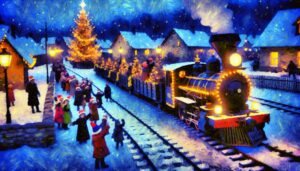Christmas and Thanksgiving, though distinct in their essence, share a common thread of gratitude and celebration. Thanksgiving, with its crisp autumn air and bountiful feasts, ushers in a season of reflection and appreciation for the harvest’s yield and the cherished bonds of family and community. It’s a time when hearts swell with thanks, echoing the rustling leaves that blanket the ground.
In contrast, Christmas, with its twinkling lights and joyous carols, brings forth a spirit of giving and receiving, commemorating the birth of hope and renewal. It beckons us to embrace the warmth of companionship, to exchange tokens of affection, and to find solace in the magic of the season. Together, these holidays weave a tapestry of gratitude, uniting us in the shared acknowledgment of life’s blessings, whether it be the bounty of a harvest or the gift of love and togetherness.

Christmas vs thanks giving differences
Christmas is a widely celebrated holiday that commemorates the birth of Jesus Christ in Christian tradition. It falls on December 25th each year. For many, it is a time of religious significance, marked by attending church services, singing carols, and reflecting on the biblical story of the Nativity.

Nativity Scene
Beyond its religious roots, Christmas has also become a cultural and secular holiday celebrated by people of various faiths and beliefs around the world. It is characterized by festive decorations, gift-giving, special meals, and spending time with family and friends.
Thanks Giving
Thanksgiving is a holiday celebrated in the United States, Canada, and some other countries. Its origins are rooted in both historical events and cultural traditions. Thanksgiving is celebrated on the fourth Thursday of November in the United States.
, here is a comparison table highlighting the key aspects of Christmas and Thanksgiving:
| Christmas | Thanksgiving |
|---|---|
| December 25th | Fourth Thursday of November |
| Celebration of the birth of Jesus Christ | Giving thanks and celebrating the harvest |
| Religious (Christianity) | Secular (Pilgrims and Native Americans) |
| Christmas tree, Santa Claus, Nativity scene | Turkey, Cornucopia, Pilgrim hats |
| Lights, ornaments, wreaths, stockings | Autumn leaves, pumpkins, cornucopias |
| Roast turkey, ham, Christmas pudding, cookies | Roast turkey, stuffing, cranberry sauce, pies |
| Gift giving, caroling, attending church | Family gatherings, parades, football |
| Red, green, gold | Orange, brown, yellow |
| Christmas carols and hymns | Patriotic songs, Thanksgiving-themed songs |
| “Merry Christmas” | “Happy Thanksgiving” |
| December 24th (Christmas Eve) and December 25th (Christmas Day) | Primarily one day |
| Celebrated worldwide | Primarily celebrated in the United States and Canada |
| Roots in pagan winter solstice festivals and Christian traditions | Commemorates the 1621 feast shared by the Pilgrims and Wampanoag people |
Nativity explained
The Nativity refers to the biblical story of the birth of Jesus Christ, as recounted in the New Testament of the Bible. It is a cornerstone of Christian faith and is central to the celebration of Christmas.
According to the Gospel of Luke and the Gospel of Matthew, the Nativity story unfolds in Bethlehem, a town in ancient Judea, during the time of the Roman Empire. Mary, a young woman engaged to Joseph, is visited by the angel Gabriel, who announces that she will give birth to the Son of God through the Holy Spirit. This miraculous conception is known as the Annunciation.
Joseph, initially troubled by this revelation, is reassured by an angel in a dream to take Mary as his wife. They embark on a journey from Nazareth to Bethlehem to comply with a census ordered by Caesar Augustus. Arriving in Bethlehem, they find no room at the inn, and Mary gives birth to Jesus in a stable or a manger.
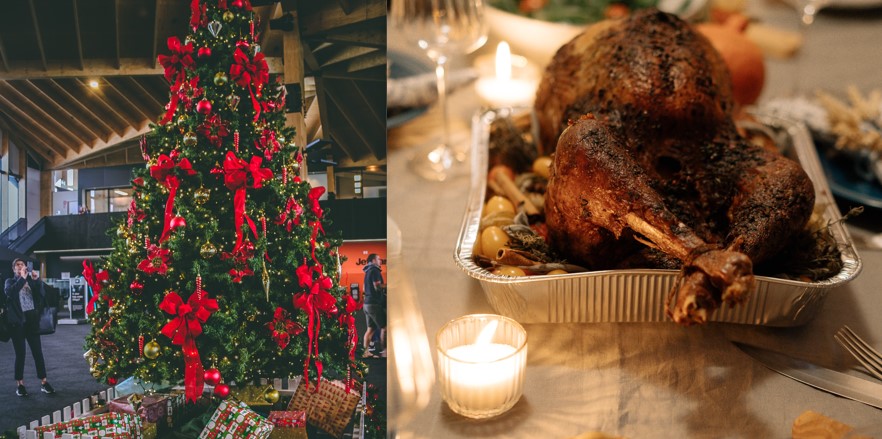
In the fields outside Bethlehem, shepherds receive a visitation from angels who announce the birth of the Savior, directing them to find the baby in a manger. They go and worship the newborn child.

Later, wise men (often referred to as the Magi or the Three Kings) from the East follow a miraculous star that leads them to Bethlehem. They bring gifts of gold, frankincense, and myrrh to honor the child, symbolizing his kingship, divinity, and eventual sacrificial death.
The Nativity story is a profound representation of God’s incarnation, as Christians believe that Jesus, born in humble circumstances, is the Son of God sent to redeem humanity. The scene of the Nativity, with Mary, Joseph, the baby Jesus, angels, shepherds, and later the wise men, has become a popular subject in Christian art, music, and literature.
The Nativity is celebrated with great reverence and joy by Christians worldwide during the Christmas season, as it signifies hope, salvation, and the promise of God’s love for humanity.
Who is Santa Clause

Santa Claus, a beloved figure in Christmas folklore, is often associated with the holiday. According to legend, Santa Claus travels in a sleigh pulled by reindeer, delivering gifts to children around the world on Christmas Eve.
The history and legend of Santa Claus is a fascinating blend of folklore, religious traditions, and commercialism that has evolved over centuries. Here is an overview of how Santa Claus came to be:
1. Early Origins:
- Saint Nicholas: The origins of Santa Claus can be traced back to Saint Nicholas, a Christian bishop who lived in the 4th century in the area now known as Turkey. He was known for his generosity and kindness, particularly towards children and the poor. Over time, he became the patron saint of children, sailors, and merchants.
2. Dutch Influence:
- Sinterklaas: In the Netherlands, Saint Nicholas, or “Sinterklaas” in Dutch, was celebrated on December 6th. This celebration involved a bishop-like figure arriving on a white horse, accompanied by his helpers, who would reward good children with treats and punish naughty ones.
3. Evolution in America:
- Dutch Settlers: Dutch settlers brought the Sinterklaas tradition to America, particularly in the New Amsterdam (now New York) area in the 17th century.
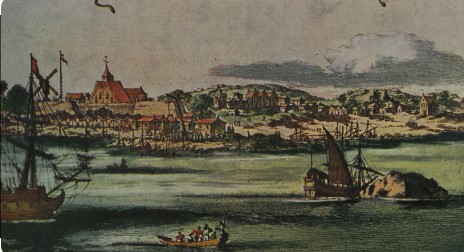
- Transformation: Over time, the figure of Sinterklaas blended with other cultural elements to form the modern Santa Claus. Washington Irving’s 1809 book “Knickerbocker’s History of New York” portrayed Santa Claus as a jolly, pipe-smoking Dutchman who flew in a wagon.

Here come Santa Claus

Christmas cookies
4. Influence of Clement Clarke Moore and Thomas Nast:
- ‘Twas the Night Before Christmas: In 1822, Clement Clarke Moore wrote the famous poem “A Visit from St. Nicholas,” which is often referred to as “‘Twas the Night Before Christmas.” This poem contributed significantly to the modern image of Santa Claus.
- Thomas Nast’s Illustrations: In the mid-19th century, the political cartoonist Thomas Nast played a crucial role in popularizing the modern image of Santa Claus through a series of illustrations for Harper’s Weekly. He depicted Santa Claus as a portly, bearded man in a red suit with white fur trim.
5. Commercialization and Iconic Image:
- Coca-Cola’s Influence: The modern, plump, red-suited Santa Claus was further popularized in the 1930s by the Coca-Cola company through a series of highly successful holiday advertisements illustrated by Haddon Sundblom.
6. Global Variations:
- Different Names and Traditions: Around the world, there are various equivalents of Santa Claus, each with unique names and traditions. For example, in France, Père Noël is the gift-bringer, while in Italy, it’s Babbo Natale.
7. Santa Today:
- Cultural Icon: Today, Santa Claus has become a universal symbol of holiday cheer and gift-giving in many parts of the world. He is an integral part of Christmas celebrations for many families.
8. The Legend Continues:
- Adaptations and Reinterpretations: The legend of Santa Claus continues to evolve and adapt, with new stories, movies, and interpretations keeping the spirit of generosity and giving alive.


Remember that the legend of Santa Claus is a blend of history, folklore, and commercial influences. It is a heartwarming story that brings joy and a sense of wonder to people of all ages during the holiday season.
Track Santa at NORAD Santa Tracker
The NORAD Santa Tracker is an annual event that has been conducted by the North American Aerospace Defense Command (NORAD) since 1955. It all began with a wrong phone number in a newspaper advertisement. The advertisement encouraged children to call Santa directly, but the phone number was misprinted and instead directed callers to the Continental Air Defense Command (CONAD) Operations Center. Kids can use the link below to Track Santa.
https://www.defense.gov/News/Feature-Stories/Story/Article/3254470/norad-tracks-santa/
https://www.noradsanta.org/en/assets/map/embed.html
Every December 1st NORAD open up its Santa Tracker For Kids All over the world to tract Santa.
Colonel Harry Shoup, who was on duty that night, instructed his staff to give the children who called in updates on Santa’s location. This tradition continued when NORAD was formed in 1958. Today, the NORAD Santa Tracker has become a popular and beloved holiday tradition around the world.
Here are some key details about the NORAD Santa Tracker:
- How It Works: NORAD uses a variety of resources to track Santa’s journey around the world on Christmas Eve. This includes radar, satellites, Santa Cams, and fighter jets.
- Website and Apps: NORAD provides a website (noradsanta.org) and mobile apps that allow people to track Santa’s progress in real-time. The website and apps also feature games, videos, and other interactive content.
- Social Media: NORAD Santa Tracker has a strong presence on social media platforms such as Twitter, Facebook, and Instagram. Updates are regularly posted to keep people informed about Santa’s whereabouts.
- Volunteers: Hundreds of volunteers, including NORAD staff and their families, help answer phone calls and emails from children and provide updates on Santa’s location. Volunteers use a variety of tools to track Santa and answer questions.
- Educational Outreach: NORAD Santa Tracker is not just about fun; it also serves as an educational tool. The program incorporates geography, technology, and other educational aspects to engage children in learning.
- Partnerships: NORAD collaborates with various corporate partners and sponsors to make the Santa Tracker program possible. These partnerships often include promotional events and activities.
The Christmas Tree
The history and legend of the Christmas tree are intertwined with various cultural traditions and have evolved over many centuries. Here is an overview of how the Christmas tree has become a central symbol of the holiday season:
Ancient Roots: The use of evergreen trees and plants in winter celebrations has ancient origins. Many cultures, including the Egyptians, Romans, and Druids, viewed evergreen plants as symbols of life, renewal, and protection against the harshness of winter.
Medieval Germany: One of the earliest recorded instances of a tree being decorated and used in a Christmas celebration comes from 16th-century Germany. It is believed that devout Christians in Germany began bringing decorated trees into their homes to celebrate the birth of Jesus. These trees were adorned with candles and symbolic ornaments.
Martin Luther and the Protestant Reformation: Legend has it that Martin Luther, a key figure in the Protestant Reformation, was inspired by the stars shining through the evergreen trees. He is said to have brought a small fir tree into his home and decorated it with candles, likening them to the starry sky. This event is often cited as one of the earliest instances of using candles to illuminate a Christmas tree.
Spread Across Europe: By the 17th century, the tradition of the Christmas tree had spread to other parts of Europe. In England, it became fashionable among the royal court after Queen Charlotte, the German-born wife of King George III, introduced the Christmas tree.
Introduction to North America: German settlers brought the tradition of the Christmas tree to North America in the 17th century. However, the custom did not become widespread in America until the 19th century, partly due to the influence of the British royal family and the publication of popular books like “A Christmas Carol” by Charles Dickens, which featured a decorated Christmas tree.

Victorian Era and the Christmas Tree’s Popularity: During the Victorian era in the 19th century, the Christmas tree became a widely embraced symbol of the holiday season. The British royal family, particularly Queen Victoria and Prince Albert (who was of German heritage), were depicted in popular illustrations with a decorated Christmas tree. This helped solidify the tree’s popularity.
Electric Lights and Commercialization: The introduction of electric lights in the late 19th century made it safer and more practical to light Christmas trees. This innovation contributed to the widespread adoption of the tradition.
Modern Traditions: Today, the Christmas tree is a central symbol of Christmas celebrations in many parts of the world. Families decorate trees with ornaments, lights, and other decorations, and they are often placed in homes, public spaces, and town squares.
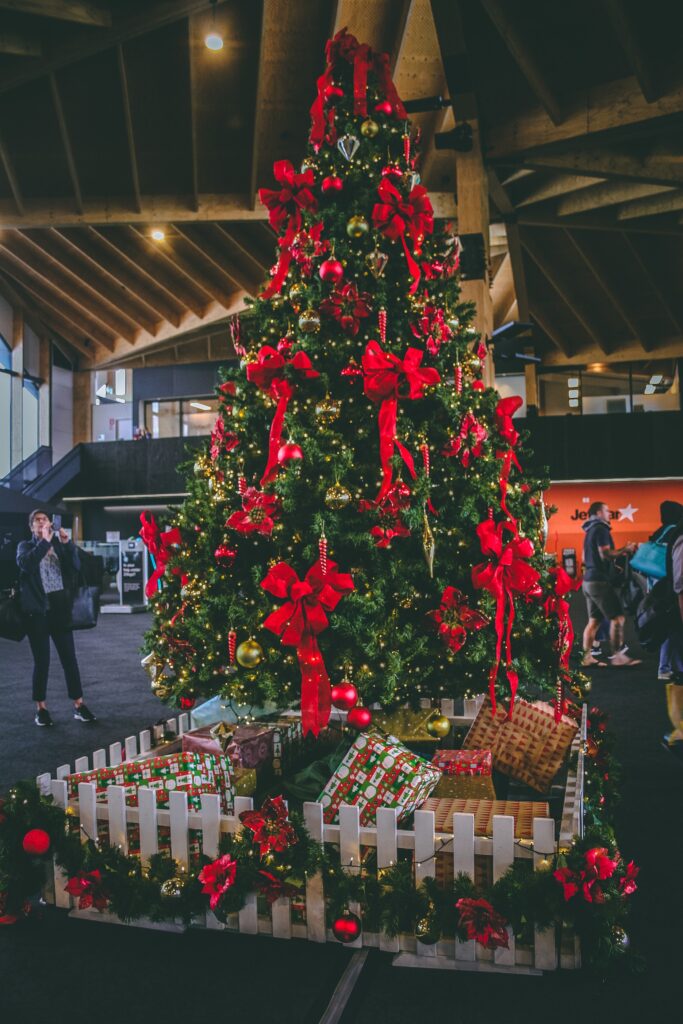
The history and legend of the Christmas tree reflect the blending of cultural traditions, religious symbolism, and a desire to bring light and life to the darkest days of winter. It continues to be a cherished part of the holiday season for millions of people around the globe.
Overall, Christmas is a time of joy, generosity, and goodwill, where people come together to celebrate and spread love and kindness. While its religious significance is central to many, its cultural impact extends far beyond the boundaries of any specific faith, making it a widely cherished and anticipated holiday.
History of Thanks Giving in the United States:
The first widely recognized Thanksgiving in the United States took place in 1621 at Plymouth, Massachusetts. The Pilgrims, English settlers who had come to America seeking religious freedom, celebrated a successful harvest with the Wampanoag Native Americans. This event is often considered the precursor to the modern Thanksgiving holiday.
The Pilgrims, who were struggling with disease and harsh conditions in their new home, were taught agricultural techniques by the Wampanoag, which helped them survive. The celebration lasted for several days and included feasting, entertainment, and expressions of gratitude.
Thanksgiving Becomes an Annual Tradition:
The early American colonies occasionally held thanksgiving-like celebrations, but it wasn’t until the 19th century that Thanksgiving became an annual holiday. Sarah Josepha Hale, a prominent writer and editor, played a significant role in advocating for the establishment of Thanksgiving as a national holiday. She wrote numerous editorials and letters to influential figures, including presidents, urging them to make Thanksgiving an official holiday.

President Abraham Lincoln’s Proclamation:
In 1863, during the midst of the Civil War, President Abraham Lincoln heeded Hale’s advice and issued a proclamation declaring Thanksgiving a national holiday. He set the date for the final Thursday in November, and this tradition was followed until 1941 when it was officially changed to the fourth Thursday in November.
Modern Thanksgiving:
Today, Thanksgiving is a time for families and friends to come together, express gratitude for the blessings of the past year, and enjoy a feast. Traditional dishes like roast turkey, stuffing, cranberry sauce, and pumpkin pie are commonly served.
Macy’s Thanks Giving Day Parade
The Macy’s Thanksgiving Day Parade is an annual event in New York City, organized by the U.S.-based department store chain Macy’s. Inaugurated in 1924, it stands as the second-oldest Thanksgiving parade in the United States, sharing this distinction with Detroit’s America’s Thanksgiving Parade, both trailing Philadelphia’s Thanksgiving Day Parade by four years. Spanning three hours, the parade unfolds along the streets of Manhattan, concluding outside Macy’s Herald Square. Commencing at 9:00 a.m. and concluding at 12:00 p.m. Eastern Standard Time on Thanksgiving Day, the spectacle has been nationally broadcast on NBC since 1953.
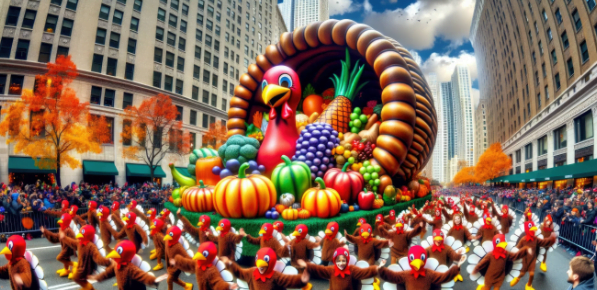
In 1924, Macy’s employees marched to the flagship store on 34th Street, dressed in colorful costumes, with floats, bands, and animals from Central Park Zoo. The parade ended with Santa Claus at Herald Square. Santa was crowned “King of the Kiddies” on the store balcony, marking the start of an annual tradition. Despite initial modest media coverage, the parade’s success led Macy’s to make it a yearly event. The parade’s popularity eventually overshadowed Ragamuffin Day, a children’s Thanksgiving activity from 1870. Ragamuffin Day involved kids going door-to-door in a primitive form of trick-or-treating, but public disapproval in the 1930s, amid the Great Depression, led to alternatives like Macy’s parade. Despite some competition, the last Ragamuffin Parade in New York City occurred in 1956.
Thanksgiving in Canada:
In Canada, the origins of Thanksgiving are different. It is believed to have originated from a combination of European harvest festivals and Native American celebrations. The date of Canadian Thanksgiving varies from that of the United States and is celebrated on the second Monday in October.
Legends and Folklore
While the historical origins of Thanksgiving are well-documented, there are also various legends and folklore associated with the holiday. One such legend is that of the First Thanksgiving, which has been passed down through generations. It romanticizes the encounter between the Pilgrims and the Wampanoag, emphasizing themes of unity and cooperation.
It’s important to note that while Thanksgiving has a rich historical and cultural significance, there are also complex and often somber aspects to the history, particularly regarding the treatment of Native American populations. This aspect is increasingly acknowledged and discussed in modern interpretations of the holiday.
Overall, Thanksgiving is a holiday that celebrates gratitude, unity, and the blessings of the harvest season. It brings families and communities together in a spirit of thankfulness.
Resources
https://en.wikipedia.org/wiki/Thanksgiving
https://en.wikipedia.org/wiki/Christmas
https://www.noradsanta.org/en/
https://www.defense.gov/News/Feature-Stories/Story/Article/3254470/norad-tracks-santa/











